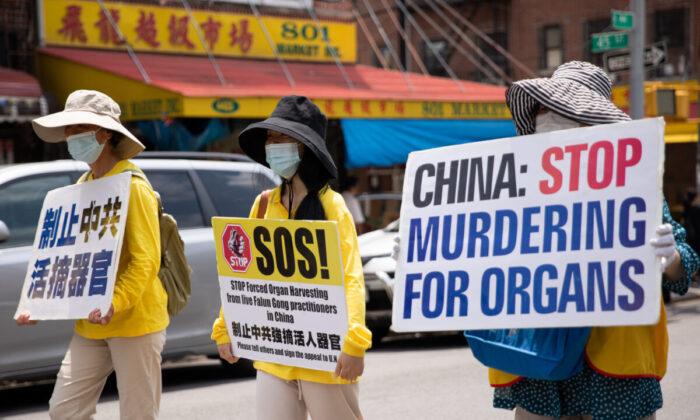Like most countries around the world, China’s history includes periods of war, blood, and struggle as dynasties topple and rulers change. But unlike other prosperous nations, the modern history is worse, not better.
For over a decade, China has been the center stage of a new crime against its own people and a crime against humanity—the harvesting of organs from Falun Gong practitioners in China.
Healing and Purpose
Wei became a Falun Gong practitioner while looking for a natural way to heal her body. As a printmaker, working with harsh chemicals took its toll on her liver. In 1998 while in New York, she found the spiritual practice Falun Gong and started to practice the five sets of meditative exercises.The practice gave Wei a new sense of her place in the world and a new sense of purpose.
“Before I became a Falun Gong practitioner it was all about me,” Wei recounts pointing her gaze down and gesturing imaginary blinkers on either side of her head. “Now, my head is raised and I see so many things,” she said.
One year later, the communist regime unleashed its propaganda machine and started arresting and persecuting practitioners whose numbers within China was estimated to be 100 million people.
Stories of courage and heartbreaking cruelty started emerging.
Crime Against Humanity
As a Falun Gong practitioner herself, Wei decided to create the book “Buddha’s Tears” when she read “The Slaughter”—a book written by award-winning investigative journalist Ethan Gutmann. In it, he estimates that 64,000 prisoners practicing Falun Gong may have been killed for their organs between 2000 and 2008 in China.“If you are going to China right now to get an organ, chances are, a perfectly innocent person is dying for you,” said Gutmann in the official trailer about his book posted by the International Coalition to End Organ Pillaging in China.
Visual Interpretation
One day, Wei received a package wrapped in layers and layers of paper and plastic. In it, she found three photographs showing a Falun Gong practitioner—a young man, unfurling a golden banner on Tiananmen Square with the three principles in Chinese: Zhen, Shan, Ren. They were the first poignant images that remain to this day as testimony to the courage of practitioners in China. Wei decided to release them to the media, but also created a series of etchings.Since then, she has written articles, produced short films and and created other works protesting against the persecution of Falun Gong practitioners under China’s communist regime.
In “Buddha’s Tears,” Wei presents statistics, graphs, dates, maps, and drawings; she joins the dots between some stark truths that unravel with heartbreaking ease as one turns the accordion pages of the meticulously hand-printed book. She used silkscreen, letterpress, and digital print to convey the data.
The steps of harvesting the organs are depicted as a sequence of drawings reminiscent of story boards used in film-making, while the human body appears as a map for the organs that can be extracted from it—devoid of personality, humanity, individuality.
In contrast, photographs and drawings of Falun Gong practitioners sitting in meditation are a constant reminder that the crimes are happening to people who seek to live by the principles of truthfulness, compassion, and forbearance—the tenets of the practice.
On one of the pages, a map of China in blood red, cut in two halves by the precision of a scalpel then rejoined with surgical stitching suggests a permanent wound, but also the possibility of healing. It asks what will remain of China at the end of it?
Inadvertently, the book also posits the same question to the western world, since such crimes are crimes against all of humanity.





